To Demonstrate Challenges in Treating Infratentorial Brain Tumors in Pediatrics at the Children’s Hospital and Institute of Child Health, Lahore
Abstract
Introduction: This study aims to measure the outcome and lag-time from the onset of symptoms till initiation of treatment in infratentorial tumors in children in resource-limited settings.
Methodology: This Descriptive observational study was done at the Department of Pediatric Hematology and Oncology at CH&UCH Lahore from August 2021 to February 2022. Sixty-four newly diagnosed patients of infratentorial tumors were enrolled by using a non-probability, consecutive sampling technique. The main variables of the study were age, parents’ education, socioeconomic status, traveling distance, TLS, staging workup, Histopathology, Treatment, and Outcome. SPSS version 23.1 was used for data analysis. A test of significance was applied, taking a p-value ≤0.05 as a significant value.
Results: In this study, the mean age of children was 7.14 ± 3.76 years. Out of 64 children, 35 (54.7%) were males and 29 (45.3%) females. Forty-three (67%) patients belong to rural areas and 21 (32%) to urban areas. In our study population, fathers of 24 (37.5%) patients and mothers of 38 (59.37%) patients never attended school. Fifty-six (87.5%) patients belong to low-income socioeconomic status, while 8(12.5%) patients are from middle-income status. Thirty-four (53.12%) patients had travelled for more than 200 km.
Lag time 1 (patient interval) was <2 weeks in 43 (67.2%) cases, and 2-4 weeks in 20 (31.3%) cases. Lag time 2 (referred interval) was noted as <1 Month in 19 (29.7%) cases, and <2 Months in 26 (40.6%) cases. Lag time 3 (treatment interval) was noted in <1 Month in 2 (3.1%) cases, and <2 Months in 6 (9.4%) cases, but in 48 (75.0%) cases, lag time 3 was not applicable. Out of 64 cases, cure with Gross Total Resection was noted in 5 (7.8%) cases, residual tumor in 21 (32.8%), and palliation in 37 (57.8%) cases.
Conclusion: Advanced disease presentation is common, infratentorial brain tumors are always challenging, and have the least favorable outcomes amongst all pediatric tumors. Delayed diagnosis due to cultural and financial barriers and lack of care at the primary health care level, and poor referral to oncology units owing to a deficient health care system are the major contributory challenges for management and poor outcomes.





